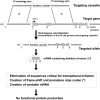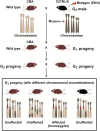Mouse models in male fertility research
- PMID: 21057516
- PMCID: PMC3739380
- DOI: 10.1038/aja.2010.101
Mouse models in male fertility research
Abstract
Limited knowledge of the genetic causes of male infertility has resulted in few treatment and targeted therapeutic options. Although the ideal approach to identify infertility causing mutations is to conduct studies in the human population, this approach has progressed slowly due to the limitations described herein. Given the complexity of male fertility, the entire process cannot be modeled in vitro. As such, animal models, in particular mouse models, provide a valuable alternative for gene identification and experimentation. Since the introduction of molecular biology and recent advances in animal model production, there has been a substantial acceleration in the identification and characterization of genes associated with many diseases, including infertility. Three major types of mouse models are commonly used in biomedical research, including knockout/knockin/gene-trapped, transgenic and chemical-induced point mutant mice. Using these mouse models, over 400 genes essential for male fertility have been revealed. It has, however, been estimated that thousands of genes are involved in the regulation of the complex process of male fertility, as many such genes remain to be characterized. The current review is by no means a comprehensive list of these mouse models, rather it contains examples of how mouse models have advanced our knowledge of post-natal germ cell development and male fertility regulation.
Figures





Similar articles
-
Local signalling environments and human male infertility: what we can learn from mouse models.Expert Rev Mol Med. 2010 May 11;12:e15. doi: 10.1017/S1462399410001468. Expert Rev Mol Med. 2010. PMID: 20456819 Free PMC article. Review.
-
Selected genetic aspects of male infertility--what animal models tell us.Folia Biol (Praha). 2003;49(4):129-41. Folia Biol (Praha). 2003. PMID: 12971582 Review.
-
Proteomics of spermatogenesis: from protein lists to understanding the regulation of male fertility and infertility.Asian J Androl. 2011 Jan;13(1):18-23. doi: 10.1038/aja.2010.71. Epub 2010 Nov 15. Asian J Androl. 2011. PMID: 21076435 Free PMC article. Review.
-
Androgen receptor roles in spermatogenesis and fertility: lessons from testicular cell-specific androgen receptor knockout mice.Endocr Rev. 2009 Apr;30(2):119-32. doi: 10.1210/er.2008-0025. Epub 2009 Jan 27. Endocr Rev. 2009. PMID: 19176467 Free PMC article. Review.
-
Genetics of male fertility.Methods Mol Biol. 2014;1154:25-37. doi: 10.1007/978-1-4939-0659-8_2. Methods Mol Biol. 2014. PMID: 24782004
Cited by
-
Efficient GFP-labeling and analysis of spermatogenic cells using the IRG transgene and flow cytometry.Genesis. 2019 Apr;57(4):e23283. doi: 10.1002/dvg.23283. Epub 2019 Feb 6. Genesis. 2019. PMID: 30663216 Free PMC article.
-
Safety and Toxicity Implications of Multifunctional Drug Delivery Nanocarriers on Reproductive Systems In Vitro and In Vivo.Front Toxicol. 2022 Jun 15;4:895667. doi: 10.3389/ftox.2022.895667. eCollection 2022. Front Toxicol. 2022. PMID: 35785262 Free PMC article. Review.
-
High quality RNA in semen and sperm: isolation, analysis and potential application in clinical testing.J Urol. 2015 Jan;193(1):352-9. doi: 10.1016/j.juro.2014.07.107. Epub 2014 Aug 1. J Urol. 2015. PMID: 25088949 Free PMC article.
-
Roles of RNA-binding Proteins and Post-transcriptional Regulation in Driving Male Germ Cell Development in the Mouse.Adv Exp Med Biol. 2016;907:123-51. doi: 10.1007/978-3-319-29073-7_6. Adv Exp Med Biol. 2016. PMID: 27256385 Free PMC article.
-
Mutations involving the SRY-related gene SOX8 are associated with a spectrum of human reproductive anomalies.Hum Mol Genet. 2018 Apr 1;27(7):1228-1240. doi: 10.1093/hmg/ddy037. Hum Mol Genet. 2018. PMID: 29373757 Free PMC article. Clinical Trial.
References
-
- Leifke E, Nieschlag E. Male infertility treatment in the light of evidence-based medicine. Andrologia. 1996;28 Suppl 1:23–30. - PubMed
-
- de Kretser DM. Male infertility. Lancet. 1997;349:787–90. - PubMed
-
- de Kretser DM, Baker HW. Infertility in men: recent advances and continuing controversies. J Clin Endocrinol Metab. 1999;84:3443–50. - PubMed
-
- O'Flynn O'Brien KL, Varghese AC, Agarwal A. The genetic causes of male factor infertility: a review. Fertil Steril. 2010;93:1–12. - PubMed
Publication types
MeSH terms
LinkOut - more resources
Full Text Sources
Other Literature Sources
Medical
Research Materials

